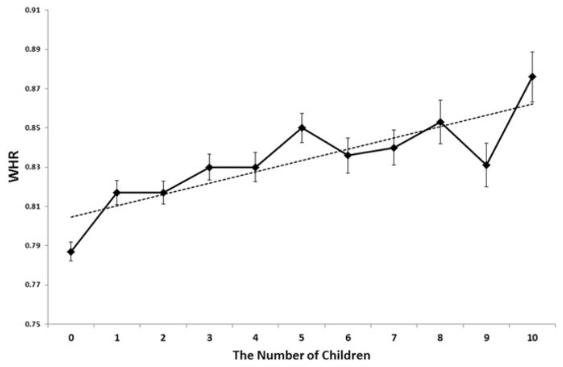Health
The Relationship Between Waist-Hip Ratio and Fertility
Research from traditional societies provides dramatic new evidence.
Posted June 19, 2017 Reviewed by Ekua Hagan
Around the globe, across cultures, and throughout history, one physical feature has stood out as consistently correlated with attractiveness in females: waist-hip-ratio (WHR). The desirability of a low WHR often cuts across other preferences in body size and shape both among individuals and in cultural predominance.
An attractive waist-hip-ratio (WHR) can come from a skinny waist, wide hips, large posterior, or any combination thereof. Of course, "attractiveness" is something that is deeply personal, highly subjective, culturally influenced, and impossible to fully articulate. Nevertheless, the attractiveness of a low WHR has held up in many cross-cultural studies (though it is definitely not universal among individuals anywhere).
Interestingly, the preference for a low waist-hip-ratio (WHR) is not purely sexual. When studies have asked participants to rate female bodies on attractiveness, both heterosexual women and homosexual men mostly mirror their heterosexual male counterparts in identifying a low WHR as attractive, even when they are divergent in how they rate other physical features. All of this speaks to some kind of ingrained preference or instinct, but why would that be?
Most theories have focused on WHR as an indicator of health and fertility. Indeed, in both males and females, a low WHR does correlate reasonably well with cardiovascular health and longevity, while a high WHR puts us at greater risk for diabetes and even autoimmune diseases and cancer. While the average ratio is different in men and women, the correlation to health holds. In women, the best health picture is found in those with so-called "pear-shaped" body proportions. While in men, the ideal ratio is achieved by minimizing belly fat. For both men and women, WHR is a better measure of health than weight alone, BMI, or physical fitness.
In women, the connection between WHR and health measures appears to be hormonal. It is known that ratios of estrogen, progesterone, and prolactin affect all of these features. The "right" balance promotes both health and low WHR. One version of the "attractiveness theory" posits that our attraction to this body shape developed as an indicator of overall health.
As I wrote previously, certain vocal features also correlate well with low WHR in women and, you guessed it, these vocal features are present in voices that most people rate as attractive. Once again, hormone ratios seem to be the connection. The effect of a "good" hormone balance can be detected in vocal features as well as body shape.
Other studies have found that we are even capable of smelling our way toward this favorable hormonal balance.
A crucial part of the attractiveness theory is that the low WHR has to be indicative of something related to fertility, or else it wouldn't have any evolutionary value. The key feature in a potential mate is biological fitness, that is, the potential to give birth to many healthy and successful offspring.
Desirable females, in the evolutionary sense, are those that are likely to be healthy, fertile, and robust. A low WHR, it is thought, must correlate with fertility (ability to have children) and/or fecundity (tendency to have large numbers of children).
Attempts to establish this relationship have given murky results. Some studies have found a connection between low WHR and fertility, but others have not. Furthermore, it is not always possible to separate fertility from health. Women in better health tend to have more children than those with chronic health problems. So the question is, does our attraction to low WHR have anything to do with fertility?
The result of a large cross-cultural study regarding WHR and reproductive history of females has just been announced. This study examined seven traditional societies, that is, peoples living in pre-agricultural conditions largely independent of industrialized culture. These seven societies are spread across three continents: Africa, South America, and Asia, and one island population in Indonesia. This is as "cross-cultural" as it gets.
Led by Piotr Sorokowski at the University of Wroclaw in Poland, the researchers measured the WHR of nearly 1,000 women and plotted those measures against reproductive history. In their sample were women ranging in age from 13 to 95. They utilized both age and body-mass index (BMI) as control variables as they attempted to focus solely on fertility and WHR.
The results are dramatic. Both BMI and age separately correlated with the number of children that the women had. No surprise there. However, even when age and BMI are normalized, the researchers observed a subtle, but direct linear relationship between waist-hip ratio and number of children:

The graph above is the result of pooled data, but each population was considered individually and the result was consistent: number of children predicts WHR ratio weakly but significantly (p<.001 for all analyses). (For a longer discussion about the value of using traditional societies for this study, click here.)
This finding turns the traditional thinking about WHR and fertility on its head. At first glance, it appears that greater fertility is found in women with a high WHR, the opposite of what would be expected using current theories. But that is not what these data are telling us. Because this is a cross-sectional study, interpreting the data requires more nuance. (A cross-sectional study is like a "snap-shot," it doesn't follow individuals over time.)
To understand the data, we must invert the relationship. Rather than waist-hip ratio being purely predictive of future fertility, it may also be reflective of past fertility. In other words, other things being equal, a lower WHR in these women may indicate that they have not had many (or any) children. This could signal to a potential mate that a female's days of reproductive investment are ahead of her, not behind her.
Another way to say this is that women transition from low to high WHR as they give birth to more children, a conclusion supported by this study and others.
Thus, the attractiveness of a low WHR could have evolved as a means of helping men detect and favor those with greater future reproductive potential, not just fertility in general. As Kasia Pisanski, the vocal experiment who discovered the connection between vocal features and WHR, told me, "I find [that argument] convincing, that a high WHR could indicate that a woman already has children (men don’t want to invest resources in another man’s children)."
This interpretation especially makes sense if we consider that a low WHR does indeed correlate well with potential fertility in nulliparous (childless) women.
So, rather than contradicting the prevailing thinking about why we are attracted to a low WHR, this result strengthens and extends the attractiveness theory. In general, this attraction could have been favored by evolution because a low WHR is a good indicator of the kind of hormonal balance that supports health and reproductive potential. It is also a reliable indicator that a woman has not already had a large number of children.
Waist-hip-ratio is a fascinating phenomenon in evolutionary psychology. If this physical feature truly correlates with future reproductive potential, it makes sense that we would have evolved to find it attractive. Of course, this cannot be considered in isolation. There are also confounding variables of social rank, physical health and prowess, and even hereditary social position. The many complications of the variables at hand, attractiveness, health, fertility, probably explain the weakness of the correlation. Individuals have individual tastes and desires, both for their mate and for their own future.
Nevertheless, given that a mechanistic connection in the form of hormonal balance has been found, a real biological and evolutionary phenomenon seems to be at play here. A low waist-hip ratio is caused at least in part by the hormonal status that also leads to cardiovascular health and reproductive success. It only makes sense that many humans find a low waist-hip ratio attractive.
References
Butovskaya, M., Sorokowska, A., Karwowski, M., Sabiniewicz, A., Fedenok, J., Dronova, D., ... & Sorokowski, P. (2017). Waist-to-hip ratio, body-mass index, age and number of children in seven traditional societies. Scientific Reports, 7.




